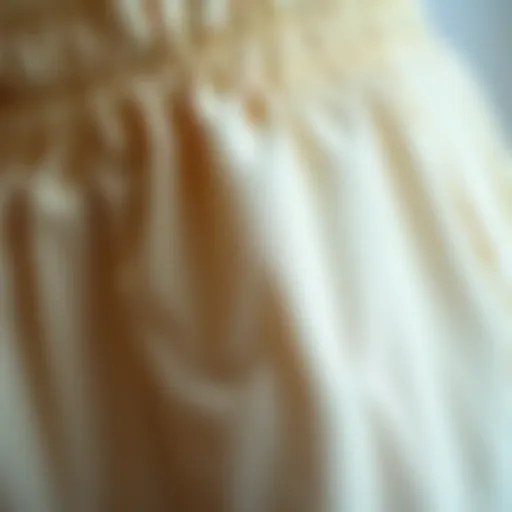The Art of Simple Linen Curtains: A Comprehensive Guide
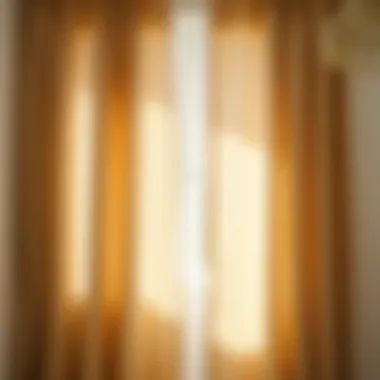
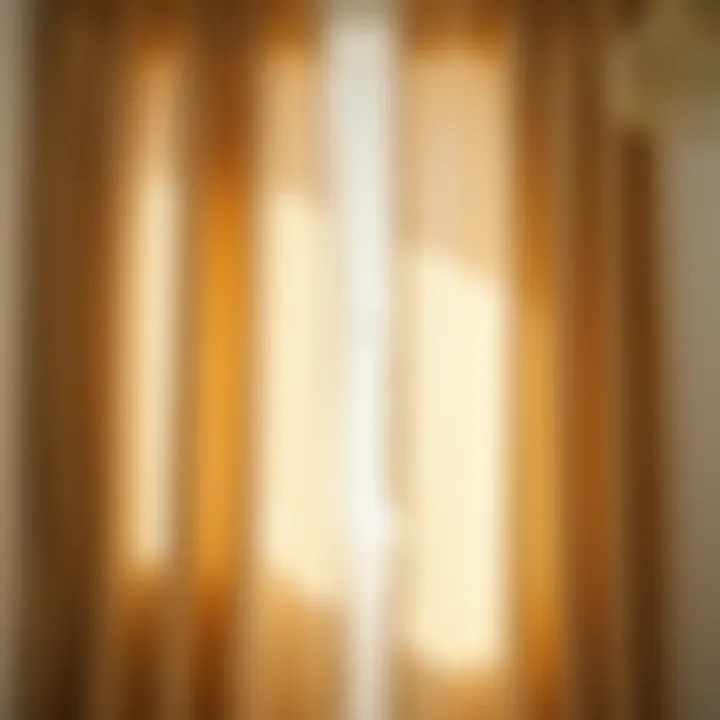
Intro
When it comes to enhancing the beauty of a room, curtains play a crucial role. Among the myriad of options available, simple linen curtains stand out not just for their aesthetic appeal but also for their remarkable versatility. Linen, with its natural texture and breathable quality, adds a touch of elegance that can transform any space. As we navigate through this guide, we'll explore the characteristics that make linen a favored choice in interior design. We’ll break down the essential elements of selecting, maintaining, and styling these timeless textiles.
Fashion Trends
Latest Seasonal Trends
In the realm of interior design, trends can shift faster than a New York minute. This season, the focus is on minimalist approaches that highlight natural materials. Linen curtains, in soft, muted tones like sage green, dusty rose, and classic white, are trending. These colors not only blend seamlessly with diverse palettes but also radiate a sense of calm.
Additionally, the trend of layering continues. Combining simple linen curtains with sheer fabrics or heavier drapes can create a visually appealing, multidimensional look. The interplay of textures adds depth, enhancing the overall ambiance of the room.
Iconic Styles Revived
Linen curtains have always had a classic vibe, but certain styles are making a comeback. For instance, the ’70s bohemian look is in full swing, with earth tones and patterns reminiscent of that era. Think linen curtains adorned with subtle patterns or earthy shades that evoke nostalgia while staying fresh.
Remarkably, the minimalist Scandinavian design ethos continues to influence the use of linen. The simple yet functional aesthetics shine through in tailored, unembellished curtain styles that emphasize the fabric's natural beauty.
"Linen curtains effortlessly merge functionality and style, making them a timeless choice for any decor."
Style Tips
How to Mix and Match
Mixing and matching linen curtains with other elements in your home can elevate your interior. Consider these strategies:
- Complement with colors: Use curtains that contrast or complement wall colors to create a cohesive look.
- Pair with different fabrics: Combine linen with cotton or silk for a rich sensory experience. Textiles of different weights can create visual interest without overwhelming the space.
- Balance patterns and textures: If your cushions or rugs have patterns, opt for solid linen curtains to keep the focus balanced. Alternatively, patterned curtains can be a statement piece, provided the rest of the decor remains understated.
Dressing for Different Occasions
Simple linen curtains can easily adapt to various settings, making them ideal for different occasions. Whether it’s a casual gathering or a formal event, here’s how you can style:
- Home Parties: Light-colored linen gives an airy feel, suitable for gatherings.
- Formal Dinners: Deep tones or patterned linen can lend sophistication to the atmosphere.
- Relaxing Space: Soft pastel shades or lightweight linen can create a serene nook for family time or reading.
Intro to Simple Linen Curtains
Linen curtains possess a unique charm that elevates any home decor. Their textured appearance and light, airy qualities bring an element of sophistication yet simplicity to the spaces they adorn. In this guide, we will explore why selecting linen curtains transcends mere functionality, and how they can become a pivotal part of your design choices.
Defining Linen and Its Properties
Linen is a natural fiber derived from the flax plant. It stands out due to its remarkable properties that blend beauty and utility. Known for its strength and breathability, linen is resistant to fading and has a natural ability to regulate temperature, keeping interiors cool in summer and warm in winter.
Moreover, unlike many other fabrics, linen gains character as it ages, developing a soft patina over time. This is not just a textile; it's a living fabric. The slight irregularities characteristic of linen reflect its handmade origins, and each piece tells its own story. The texture is distinct, lending itself to both rustic and upscale interior designs.
Historical Context of Linen Use
Linen has been in use for thousands of years, making it one of the oldest textiles known to humankind. From ancient Egypt, where it was prized for its durability and used in mummification, to its prevalence throughout Europe during the Middle Ages, linen has held cultural significance. In fact, the term 'linen' originates from the Latin word 'linum' and has been woven into the fabric of history.
Through various eras, linen was reserved for the wealthy or used in ceremonial garments, symbolizing purity and elegance. In modern times, this fabric continues to bridge the gap between history and contemporary design, proving its relevance in today’s home interiors. The resurgence of handcrafted and sustainable materials echoes a collective yearning for authenticity, making linen a favorite choice among stylists, designers, and homeowners alike.
In summary, the combination of linen's exceptional properties, its historical significance, and its evolving role in contemporary design underscores its importance in the realm of simple curtains. Embracing linen not only adds visual appeal to interiors but also aligns with a growing trend of sustainability and quality craftsmanship.
The Aesthetic Appeal of Linen Curtains
When thinking of interior design, aesthetic appeal often reigns supreme, guiding choices in everything from furniture to textiles. Linen curtains, with their unique charm, can change the entire feel of a room, balancing elegance with a touch of earthiness. They naturally fit into both traditional and contemporary settings, making them an excellent choice for those looking to enhance their décor.
One of the critical elements of selecting curtains is how they influence the overall atmosphere of a space. Linen curtains offer a soft and welcoming ambiance. The natural fibers breathe beautifully, allowing light to filter through gracefully. This light filtration is not just about illumination; it's also about creating mood and depth in a room. Imagine a sun-drenched morning, where soft rays of light drizzle through your linen curtains, casting a gentle glow, enriching the space without overwhelming it.
Furthermore, the texture of linen gives curtains an organic quality. It’s less stiff than synthetic options, which can sometimes feel harsh or overly formal. Instead, linen has a natural drape, which helps it fall elegantly, ensuring a more fluid and relaxed look, a feature often sought after in modern interiors. The aesthetic beauty of linen curtains lies not just in their appearance, but also in the feelings they invoke—comfort, warmth, and simplicity.
Texture and Light Filtration
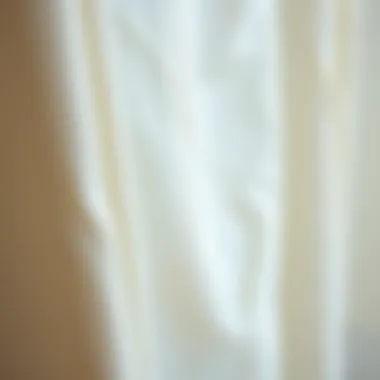

Linen’s texture is one of its most appealing attributes. It possesses a slightly wrinkled finish, which enhances its informal charm. This isn’t a flaw but rather a characteristic that many people find desirable. The fabric does not require obsessive ironing, allowing it to maintain a more relaxed look that aligns with contemporary lifestyle needs.
When it comes to light filtration, linen excels. Unlike heavy drapes that block out sunlight completely, linen curtains allow a soft diffusion of light. Depending on the weave and thickness, you might find yourself with curtains that filter light while still providing privacy. This unique challenge—balancing light and privacy—can be beautifully met with linen.
Many designers often recommend layering linen curtains with sheer fabrics. This offers the best of both worlds: vibrant light during the day and subtle privacy at night. Layering not only enhances the aesthetic appeal but also elevates the depth and complexity of window treatments.
"The difference between ordinary and extraordinary is that little extra."
- Jimmy Johnson
Color Variations and Patterns
Linen curtains come in a myriad of colors and patterns, catering to diverse tastes and decorating styles. The natural fibers of linen take dye beautifully, producing rich, earthy tones that complement a multitude of color palettes. From soft pastels to bold, vibrant hues, the options are plentiful. When selecting the right color, consider the overall theme of your room. Neutral shades—such as soft whites or delicate beiges—can brighten and enlarge a space, making them a popular choice for smaller rooms.
On the flip side, darker colors like charcoal or navy can bring depth and sophistication to a room. Patterns in linen, though less common, can also add a personalized touch. Subtle stripes or checks can introduce a hint of whimsy without overwhelming the eye, allowing your curtains to act as understated artworks.
Additionally, consider the context of the space when selecting your colors and patterns. In a child’s playroom, playful prints or vibrant hues may lift the tone, while a formal dining room might benefit from rich, solid colors that convey elegance. This adaptability is what makes linen curtains such a versatile choice in home décor.
By understanding the aesthetic appeal of linen curtains—including their texture, light filtration properties, color variations, and patterns—you can enhance your interior design in meaningful ways. These elements not only elevate the visual charm of a room but also contribute to a sense of well-being and balance in your living space.
Benefits of Choosing Linen Curtains
Choosing the right curtains can elevate your home, bringing both beauty and functionality into your space. Linen curtains stand out not only for their aesthetic quality but also for the practical benefits they offer. This section digs into why opting for linen curtains can be a wise decision, keying in on sustainability and longevity. When you think about making an investment in textiles for your home, linen truly hits the mark on several critical fronts.
Sustainability and Eco-friendliness
In today’s climate-conscious world, sustainability isn’t just a buzzword; it’s a necessity. Linen fabric is made from the flax plant, which is renowned for its low environmental impact. Flax requires less water than cotton and boasts a minimal need for pesticides or fertilizers. This natural fiber is biodegradable, meaning when it’s time to retire your curtains, they won't be cluttering landfills for years on end.
The production process of linen is relatively energy-efficient. Unlike synthetic options that can take hundreds of years to decompose, linen’s simplicity in cultivation and processing means it returns to the earth much more gracefully.
Moreover, when you choose linen, you support the agricultural practices that prioritize sustainability. In a way, each curtain you hang is a nod to a more responsible lifestyle. It’s not merely a decorative choice but a statement about making conscious, eco-friendly living a priority in your life.
Durability and Longevity
Let’s face it—no one wants to change their curtains every few months. This is where linen shines like a diamond in the rough. Linen curtains are known for their sturdiness. The fibers are naturally more robust than their cotton counterparts. They can withstand the test of time and the wear and tear of daily life.
The durability of linen doesn’t come at the cost of elegance. You might find that linen curtains actually become softer with each wash, taking on a lived-in charm that makes them feel even more inviting. That characteristic is something many rich fabrics don't have; they can lose their appeal over time.
Additionally, unlike synthetic fabrics, which can fade and fray, linen retains its color and shape remarkably well.
To sum it up, the longevity of linen curtains can save you money in the long run. With proper care, they can last for years and years, providing you with both comfort and style. So as you ponder your options, remember that a well-crafted linen curtain is an investment that transcends trends and offers timeless beauty.
"Linen's durability combined with its eco-friendly attributes make it a frontrunner in the world of textiles. It’s more than just a choice; it’s a lifestyle."
Incorporating linen curtains into your home isn’t just about enhancing aesthetics; it’s a robust decision that resonates with both your style and your values. From sustainability to durability, linen has earned its place as a favored material for those who seek not only beauty but also a bit of practicality in their decor.
Crafting Simple Linen Curtains
Creating simple linen curtains is a rewarding venture, blending functionality with personal expression. This section will walk you through essential steps that ensure your linen curtains not only look stunning but also serve their purpose effectively.
Selecting the Right Fabric
Choosing the right type of linen is the foundation of making beautiful curtains. Not all linens are created equal; they can vary in terms of weight, texture, and weave.
- Weight: Lighter linens are ideal for airy, breezy drapes that flutter with a gentle breeze, while heavier options provide a more structured look.
- Weave Types: Consider using a plain weave versus a twill weave—each offers different visual textures. A plain weave will give you a smooth and sophisticated look, while a twill weave tends to be thicker and sturdier.
- Test Samples: Always ask for swatches before committing to a fabric. This allows you to see how it behaves in different lighting conditions, which can dramatically affect your curtain’s overall aesthetic.
Measuring for Accurate Fit
Precision is key when it comes to curtain measurements. If your cuts are off, it can lead to frustration and wasted fabric. Here’s how to ensure a perfect fit:
- Width: Measure the width of your window, adding extra fabric for fullness—typically, you’ll want to extend the width by at least 1.5 to 2 times.
- Length: Decide on the desired length—whether it’s just below the window sill or touching the floor—and then measure from your chosen rod placement.
- Consider Rod Placement: The height of your curtain rod can affect the visual perception of height in a room. Placing it higher than the window frame can create an illusion of taller ceilings.
Proper measuring is the difference between curtains that look custom-crafted and ones that have a makeshift vibe.
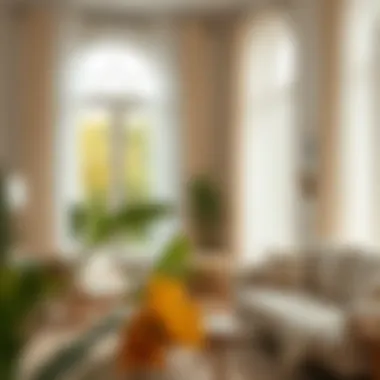
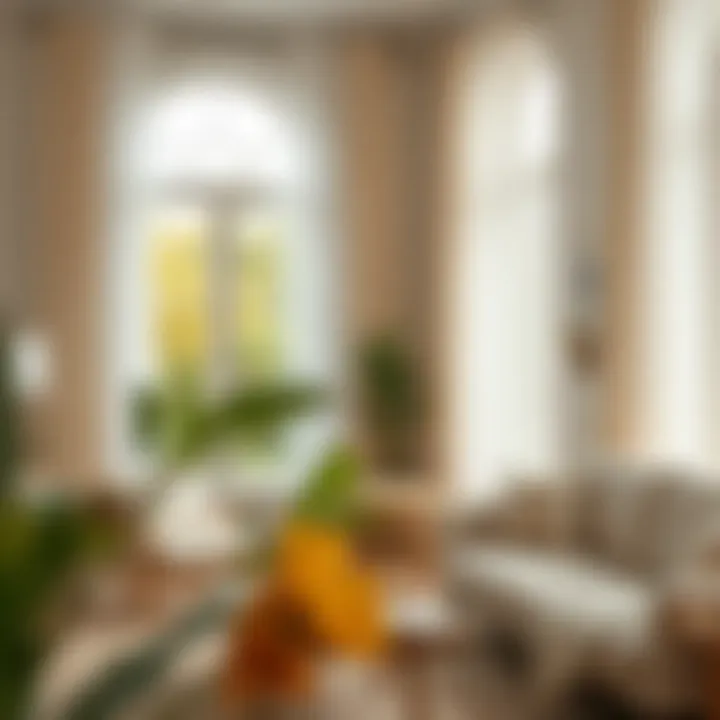
Sewing Techniques for Beginners
Sewing your own linen curtains may seem daunting at first, but with a few basic techniques, it can turn into a delightful project.
- Basic Stitching: Start with a simple straight stitch for straight seams. For hems, a double fold can lay flat and offer a clean finish.
- Using Pins: Pin your fabric before sewing; this keeps layers together and prevents shifting. For curves or shapes, consider using fabric clips instead.
- Finishing Edges: To prevent fraying, it’s wise to finish raw edges with a zigzag stitch or use a serger. This adds durability to your curtains and ensures a neat appearance.
- Practice: Don’t hesitate to practice on scrap pieces of fabric before moving to your actual curtains. This will boost your confidence and help you work out any kinks in your technique.”
Styling Your Space with Linen Curtains
When it comes to decorating your home, linen curtains can be the subtle yet impactful element that ties the entire room together. The reason why styling your space with these curtains is crucial lies in their ability to complement various design aesthetics. Whether you're going for a rustic, modern, or bohemian vibe, linen curtains provide the versatility and elegance to enhance your chosen theme. They possess a relaxed, airy quality that allows natural light to filter through while still maintaining privacy. Thus, understanding how to harmoniously integrate these curtains into your interior can significantly elevate the overall feel of your living space.
Matching Curtains with Interior Themes
Choosing the right linen curtains involves more than just picking a color; it also means aligning them with your broader interior theme. For instance, if you're leaning towards a minimalist aesthetic, opting for soft, neutral shades like beige or light grey can keep the space feeling uncluttered. In contrast, if your space screams eclectic, consider curtains that feature bold patterns or a rich jute texture. A few guidelines to keep in mind:
- Color Palette: Ensure that the curtain color complements other elements in the room, such as furniture and decor. For instance, if your living room showcases deep greens and browns, soft sage linen curtains could beautifully enhance the room’s natural warmth.
- Texture Play: The fabric’s texture can add another dimension to your room. If your furniture is slick and modern, contrasting it with the soft texture of linen can offer a sense of balance.
- Theme Consistency: Stick to your theme without outrunning into realms of chaos. If your home exhibits farmhouse chic, stick with lighter, airy, and perhaps even slightly crinkled linen for that lived-in look.
Layering Techniques for Dimension
Layering isn’t just for clothing; it’s a technique that can richly transform your window treatment as well. When using linen curtains, layering not only adds depth but also enriches textural contrast. The interplay of fabrics creates visual interest and enables varying levels of light control to suit different times of day. Here’s how you can layer effectively:
- Base Layer: Start with a sheer linen curtain to allow a soft glow of natural light while maintaining privacy for daytime. This offers a breezy feel that pairs well with many themes.
- Darker Top Layer: Add a thicker linen curtain in a darker shade. This layer can be used to block more light during the evening and can be drawn back to reveal the sheer underneath when desired. It adds a classic elegance to any window frame.
- Accessorizing: Consider adding curtain holdbacks or ties in a materials that complement both layers. This not only holds your curtains back when you want them open, but also contributes to the aesthetic.
In summary, the thoughtful application of linen curtains can greatly enhance your living space’s character and ambiance. By matching them thoughtfully with your interior theme and exploring layering techniques, you can achieve a well-styled look that feels both intentional and inviting.
"Incorporating linen curtains into your design is not merely about shade; it’s about crafting a visual narrative that resonates with the essence of the space.”
Explore more on linen fabric's versatility at Britannica.
You can also glean insights about modern interior trends using community-based resources like Reddit to connect with designers sharing their creative uses of linen.
Maintenance and Care of Linen Curtains
Proper maintenance and care of linen curtains can extend their lifespan significantly while preserving their beauty. Linen, known for its natural strength and breathability, requires specific techniques to keep it looking fresh. Neglecting this aspect can lead to a gradual decline, losing the very qualities that make it so appealing. Understanding the best practices can prevent unnecessary wear and tear, ensuring these elegant fabrics continue to grace your windows elegantly.
Washing and Drying Guidelines
When it comes to washing, linen curtains are a bit like a fine wine—they need to be handled with care. Start by checking the label for specific washing instructions, as each set might have unique needs based on their manufacturing.
- Machine vs. Hand Washing: Generally, you can machine wash linen curtains on a delicate cycle using cold water. If you want to err on the side of caution, hand washing can be gentler, as it gives you more control.
- Detergents: Use a mild detergent to prevent the fibers from breaking down. Harsh chemicals can strip the fabric of its natural oils, leading to a lackluster appearance.
- Avoid Bleach: As tempting as it might be for that extra brightness, avoid bleach! It can discolor linen and weaken the fibers over time.
Once washed, how you dry your curtains is just as important as the wash itself. It’s best to air-dry linen curtains to prevent shrinkage and maintain their shape. If you use a dryer, opt for a low heat setting and remove them while they’re slightly damp. This helps in reducing wrinkles later on.
Ironing and Storing Tips
Linen has a natural tendency to wrinkle, and while some people appreciate the relaxed look, you might prefer to maintain a crisper appearance. Irons can be your best friend here.
- Ironing While Damp: Ironing your curtains while they are slightly damp can make the task easier. A steam iron works wonders, giving you a crisp finish without much hassle.
- Temperature Settings: Always set your iron to a medium to high temperature suitable for linen. Too hot and you risk scorching, too cold and the wrinkles may not budge.
- Using a Press Cloth: If you're concerned about shine, place a piece of cotton fabric between the iron and the linen. This acts as a barrier, protecting the fabric from direct heat.
For storing, if you’re switching up the look of your space seasonally, ensure that your linen curtains are stored properly to prevent damage.
- Clean Before Storing: Always wash and completely dry your curtains before storage to avoid mildew and lingering odors.
- Wrapping: Keep your curtains in a dry, ventilated area, ideally using breathable garment bags or cotton sheets.
- Avoid Heavy Folding: Instead of folding, consider rolling them to minimize creasing and stress on the fabric.
"Linen curtains are not just about style; they reflect a lifestyle that seeks simplicity, elegance, and a connection with nature."
For more in-depth info on fabric care, you can visit The Spruce
Keeping linen curtains in top condition is about understanding the balance between care and love—a little effort goes a long way in preserving their charm.
Comparing Linen with Other Curtain Materials
When it comes to selecting curtains, materials play a pivotal role in both function and aesthetic. While linen is the star of the show, understanding how it stacks up against other options helps in making informed choices. Let's explore the nuances of linen compared to two major contenders: cotton and synthetic fabrics. This comparison highlights specific elements, benefits, and considerations that can significantly influence your decision.
Linen vs. Cotton
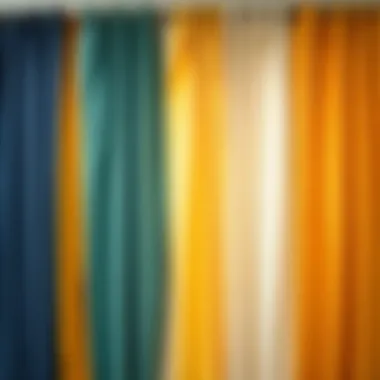
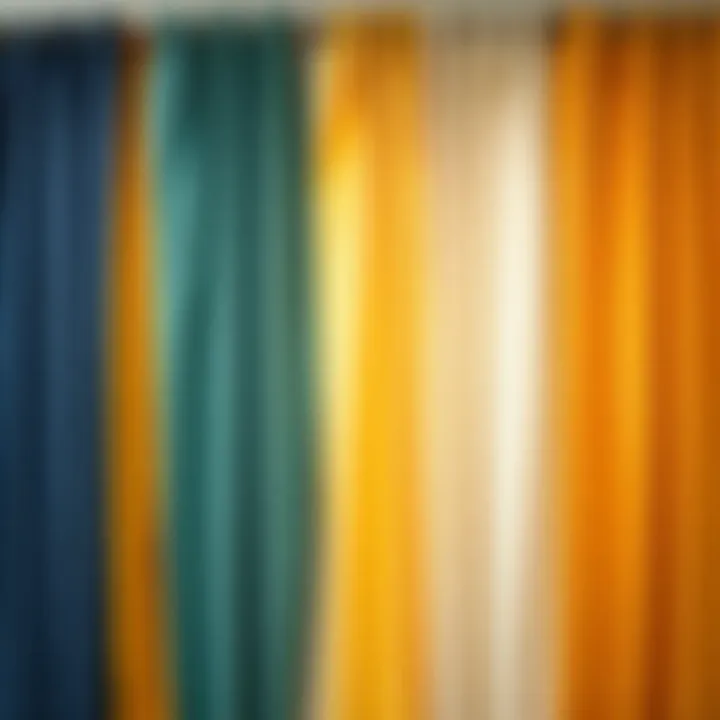
Linen and cotton are frequently tossed around as go-to choices for fabric. Yet, each brings its own flavor to the table. Here are some key points to consider:
- Breathability: Linen arguably takes the crown for breathability. It's woven from flax fibers, making it lighter and more porous than cotton. This means that on hot days, linen curtains provide a gentle breeze, helping to keep a room comfortable.
- Textural Differences: While cotton is soft and smooth, linen has a more textured, natural feel. This texture not only adds a level of depth to the décor but can handle light filtering with finesse. If you’re after a richer tactile experience, linen might just be your best buddy.
- Care and Maintenance: Cotton generally holds its shape better and is easier to wash. Linen, although durable, wrinkles easily, which can lead to a more casual look. It is crucial to decide if you want a slightly tousled aesthetic or the crisp, polished feel that cotton offers.
- Sustainability: Both fibers are relatively sustainable, but linen often boasts the edge due to the lower water and pesticide requirements in flax cultivation. If eco-friendliness is on your checklist, linen is a strong contender.
Ultimately, the choice depends on personal preference and specific environment needs. A cozy cottage might benefit from linen's charm, while a more formal setting might prefer the neatness of cotton.
Linen vs. Synthetic Fabrics
In the quest for the ideal curtain material, synthetic fabrics offer practical advantages but come with trade-offs. Here's an overview:
- Durability: Synthetic materials, like polyester, are often more durable, resisting wear and tear better than linen. If you have pets or children, this might sway your decision. However, this durability comes without the natural appeal linen possesses.
- Washability: Synthetic curtains are typically easier to clean. They often survive the rigors of the washing machine without losing shape. Meanwhile, linen needs a gentler touch, requiring specific care to maintain its integrity.
- Aesthetic and feel: Linen has a unique softness and weight that synthetic versions often lack. The natural fibers breathe in a way that synthetics can’t emulate. They often feel colder to the touch and can lack that inviting warmth found in linen.
- Environmental Factors: Synthetics are derived from petrochemicals, which raises questions about sustainability. On the other hand, linen is a renewable resource, leading many to favor it in an eco-conscious market.
In essence, the choice between linen and synthetic fabrics hinges on the lifestyle and aesthetic one desires. For those prioritizing natural beauty and sustainability, linen sings its timeless tune, whereas for practicality and ease, synthetics can hold their own.
"Choosing curtain materials is not only about looks; it’s about how they harmonize with your lifestyle and values."
In this journey of understanding fabrics, consider your home's atmosphere and personal tilt toward style and utility. Whether you fall for linen's timelessness or cotton's straightforward charm, knowing the distinct traits of these materials empowers you to make the right decision for your space.
The Role of Linen Curtains in Modern Interiors
Linen curtains play a pivotal role in the decorative and functional aspects of contemporary interiors. Their unique blend of aesthetics and practicality makes them a favored choice among stylists and homeowners alike. When considering how to integrate linen curtains into your living space, it’s essential to acknowledge the elements that contribute to their significance. Not only do these curtains enhance the overall look of a room, but they also provide benefits such as light control, insulation, and acoustics.
One key factor that makes linen curtains stand out is their versatility. They blend effortlessly with various design themes, be it minimalist, rustic, or even modern chic. The natural fibers of linen bring an earthy touch, which warms up any space without overpowering it. The sheer quality of linen allows natural light to filter through, creating a soft glow that can uplift the mood of a room while maintaining privacy.
Trends in Curtain Design
As we navigate through the evolving landscape of home decor, linen curtains are keeping pace by incorporating modern trends. Currently, there’s a noticeable shift towards minimalist designs that emphasize simplicity and functionality. Homeowners are opting for plain linen curtains in neutral colors—think soft beiges, greys, or whites. These colors not only match well with most decor styles but also provide a serene backdrop for bolder furnishings or artwork.
Additionally, the trend of layering has gained traction in recent years. Instead of single-layer curtains, many are choosing to combine linen curtains with heavier drapes or sheer panels, giving depth and texture to their windows. This approach allows for more control over light and privacy while adding an element of sophistication to the room.
Furthermore, sustainability is becoming a key influencer in fabric choices. Given that linen is derived from the flax plant, which requires fewer resources to grow, it aligns well with eco-friendly practices. Homeowners today are keen on selecting materials that are not only stylish but also environmentally conscious.
Cultural Influences on Linen Use
The use of linen curtains is deeply rooted in various cultures, reflecting traditions that span centuries. For instance, in Mediterranean countries, where the sun shines bright for most of the year, linen is preferred for its breathability and ability to keep spaces cool. These cultural preferences influence the design and color of curtains, often leading to the use of vibrant hues and intricate patterns found within local styles.
In Scandinavian design, linen is celebrated for its simplicity and functionality. The Nordic approach emphasizes minimalism, encouraging the use of soft, earthy tones in window treatments that complement the natural light of the region. Here, curtains are often used not just for privacy but as integral elements of the overall aesthetic, blending seamlessly with clean lines and nature-inspired decor.
"Linen curtains embody a perfect fusion of style and sustainability, offering a glimpse into the traditions that shape our modern dwellings."
As diverse cultural practices continue to influence how we style our homes, linen curtains remain a favorite among those who appreciate the subtleties of design while asserting a connection to heritage.
Finale: The Lasting Impact of Linen Curtains
In the realm of interior design, linen curtains have carved a niche, bringing a blend of classic elegance and modern versatility to our living spaces. They stand as not only functional pieces but also artistic statements that reflect personal style and values. As this guide elucidates, the lasting impact of linen curtains lies in their timelessness, and their ability to adapt to changing design trends while maintaining their intrinsic appeal.
From their durable nature to the eco-friendly benefits of using linen, these curtains embody both practical and aesthetic virtues that make them a prudent choice for any homeowner. Unlike synthetic materials, linen is biodegradable, supporting sustainability and a commitment to a greener environment.
Furthermore, linen curtains are not just a decorative choice; they also contribute to the mood and ambiance of a room. The way they filter light creates a soft, serene atmosphere, encouraging calm and focus. As such, linens help set the stage for beautiful living—proving that a simple element can significantly influence the overall feel of a space.
"The beauty of linen curtains is not just in their look, but in how they make a space feel."
The Timelessness of Linen
Linen, with its rich history and associations, transcends fleeting fashion. Its production dates back thousands of years, seamlessly weaving itself into the fabric of various cultures. The timelessness of linen is not merely a catchphrase; it embodies a legacy marked by quality and grace.
This fabric retains its charm across generations, maintaining a look that dances between rustic and refined. Whether gracing the windows of a country cottage or a sleek urban apartment, linen curtains provide an effortlessly chic aura. They can be dressed up with accessories for an event or left minimalistic for everyday comfort.
Through various color palettes and patterns, linen adapts without losing its identity. The subtle texture allows it to coordinate with myriad styles, ranging from farmhouse to modern minimalist, appealing to a wide audience. People appreciate the versatility linen offers, as it can effortlessly contribute to both a tranquil retreat or a vibrant social space.
Future of Linen Curtains in Design
As we look toward the future of design, linen curtains will likely hold their ground as a favored choice among stylists and designers alike. While trends are ever-evolving, the preference for natural materials continues to gain traction in an age increasingly focused on sustainability. Consumers today are more conscious about their choices, looking for resources that echo their values, and linen stands tall in this regard.
Moreover, innovations in fabric treatment and technology are enhancing the functionality of linen without compromising its intrinsic properties. Various treatments can make linen more resistant to stains and wrinkles, extending its life and usability in a home environment.
The potential fusion of traditional textiles with modern aesthetics showcases a new era of design where linen curtains play a critical role. We can expect to see bold patterns that marry historical motifs with contemporary design sensibilities. The charm of linen, paired with innovative techniques, will keep the fabric relevant and appealing.
In summary, the enduring allure of linen curtains is not just a fleeting trend, but a staple that can highlight a space and fulfill functional needs. Their sustainability, versatility, and chic look make them an essential element in modern interior design, promising a bright future as a beloved choice in home decor.





